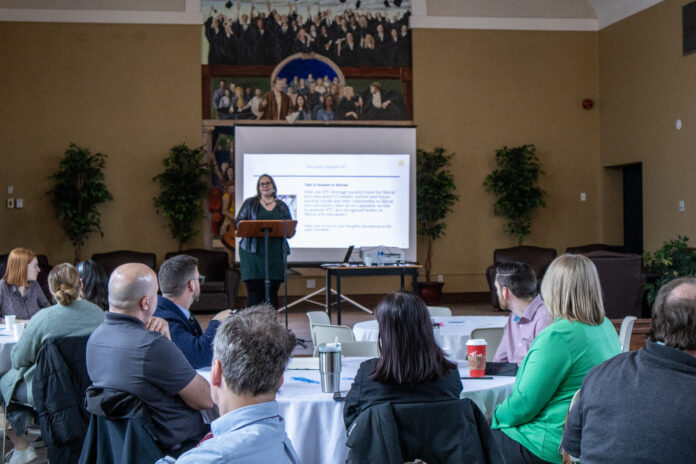

St. Thomas University hosted a facilitated discussion session, part of phase one of the university’s strategic planning process. The session was run by Academica Group, a higher education research and consultation organization.
The key discussion was around the “liberal arts” as a description for STU and how there can be misconceptions.
A mix of 40 students, faculty and staff participated in the sessions, which took place in the morning and afternoon of Feb. 26.
“We really wanted to dig into the liberal arts and the nature of STU as an academic institution,” said Academica Group senior consultant Bonnie Crocker.
Crocker has experience working with small liberal arts universities and wanted to use this session to dig into questions that require collaboration and can’t be answered on an online survey.
“The discussion about whether STU should continue to describe itself as a liberal arts institution, whether or not that evokes certain negative connotations in people’s minds … I was happy to hear that because I think that’s the type of discussion STU needs to have,” said Crocker.
Tyler Dupuis, a fourth-year political science student, thought the discussions were “effectively setup” and also recalls discussions surrounding STU’s image.
“A lot of future students don’t necessarily know what liberal arts means or the connotation that goes with that … a lot of people hear ‘liberal’ and they make up their own ideas of what it means,” said Dupuis.
Each group of students, faculty and staff had table discussions sparked by provided prompts. The prompts pertained to STU’s image rather than the university’s content such as courses, research, facilities, or services. The event was a follow up to a prior survey which was sent out to the STU community. The survey displayed questions about STU’s image.
Crocker was pleased with the turnout and mix of participants.
“We wanted to make sure that we had good engagement from stakeholders, this is what we call a bottom-up process where we’re engaging everyone and want to hear their opinions,” she said.
Dupuis said it was important that students participated and that the mix of participants at his table were all there for the common goal of developing STU’s future.
A future that Crocker hopes a strategic plan will help deliver.
“At a very basic level strategic planning is figuring out where you are now and where you want to go, the strategic plan is how you are going to get there,” Crocker said.
Each discussion group gathered notes which will be compiled and a part of a report that will be brought back to STU.
“We’re just compiling the themes from the pages and pages of notes that we collected on the two discussions we had … and I think there’s a lot of great information in there for the [strategic planning] committee,” said Crocker.
On top of the discussions, Crocker and her team collected around 40 to 50 background documents for their first report including enrolment reports and previous strategic plans.
Crocker provided the list of other stakeholder group discussions that will be included in the report:
– Chairs and directors of academic departments
– Director-level staff
– Board of governors (conducted Feb. 24)
– Growth and future committee (conducted Feb. 12)
– Senior team, deans and registrar
– STU Students’ Representative Council, student representatives on senate and senate committees
All this information as well as a competitive market and environmental scan will be presented to the strategic planning committee.
The report’s important points will be presented to the university community on March 25.
